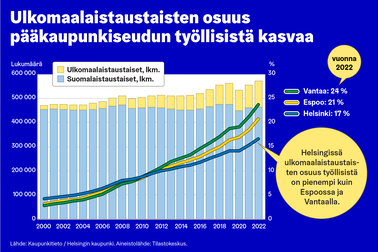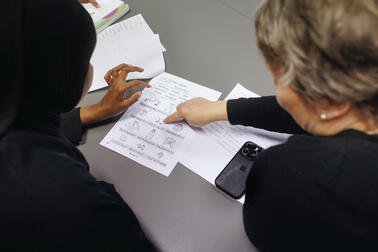
The number and population share of people with a foreign background has increased rapidly in the Helsinki Metropolitan Area. The cities of Espoo, Helsinki and Vantaa are monitoring the integration of immigrants and their children’s success in life. The new report updates the integration studies of the City of Helsinki with the latest data, which was mainly collected in 2018, and expands the coverage to encompass the entire metropolitan area. The focus is on determining the living conditions and life situations of immigrants, i.e. persons who have been born abroad. In addition to this, the report examines education, employment and earnings among second-generation immigrants who have been born in Finland.
The proportion of people with a foreign background among the working-age population (ages 20–64) of the Helsinki Metropolitan Area has increased rapidly. In 2018, the shares were 20% for the entire region and 18% for Helsinki. People with a foreign background accounted for almost one-third of all employees in the accommodation and food services sector in 2018. The proportion was equally high in administrative and support services at 28%. At the end of 2017, 56% of cleaners, domestic helpers and other cleaning sector workers were immigrants.
These developments are illustrated by the recent study produced by the city information unit of the Helsinki City Executive Office. The study examined employment, income levels and living conditions among immigrants in the entire metropolitan area and in Helsinki, Espoo and Vantaa specifically. Education levels were also studied with regard to second-generation immigrants born in Finland.
Variations in economic trends are clearly evident in the development of employment among immigrants
In Helsinki and more widely in the entire metropolitan area, labour force participation and employment rates are much lower and unemployment is higher among immigrants than the native population. Variations in economic trends have a significant impact on the position of immigrants in the labour market, and positive development appears to be proportional to the length of time spent in Finland, especially among women. Clear improvements in the employment situation of immigrants could be seen before the coronavirus outbreak.
Immigrants mostly rent their housing
Problems with gaining employment influence many other factors in life. For example, low income levels are reflected in the low percentage of owner-occupied housing among immigrants. In Helsinki, immigrants often rent their housing and a high percentage live in ARAVA state-subsidised or interest-subsidised rental flats, compared to the native population. Especially first-generation and second-generation immigrants who belong to a large family with children live in cramped conditions more often than persons with a Finnish background. In 2018, 40% of foreign-language households in Helsinki lived in non-subsidised rental housing units.
Second-generation immigrants are growing and reaching adulthood
Helsinki is already home to roughly 20,000 Finnish-born people whose parents were born abroad. The majority of them are younger than twenty, but a large number of them makes the transition from mandatory education to further studies and employment each year. Completed degrees and qualifications are less common among Finnish-born people with foreign background than their native peers. In terms of second-generation immigrants, education is more common among women than men, and women are also in employment more often than men.
Known phenomenon – lesser-known causes
There are some differences between Espoo, Helsinki and Vantaa, but they are mostly minor and most likely result from structural differences in the population with a foreign background. As such, the foreign-background population is very diverse and should always be broken down to more specific groups. The data collected on housing, employment and earnings in the Helsinki Metropolitan Area largely corresponds with statistics and research data regarding similar conditions.
The study primarily focuses on the year 2018 and is based on materials commissioned from Statistics Finland by the cities of Helsinki, Espoo and Vantaa and Helsinki-Uusimaa Regional Council. Alongside the City of Helsinki, Espoo and Vantaa took part in the funding of the analysis and report. The register-based materials are collected and analysed by the Helsinki City Executive Office every two years.
Read more:
Study (In finnish)
Summary (In finnish)
Statistics and research data on Helsinki
Photo: Jussi Hellsten, © City of Helsinki.


